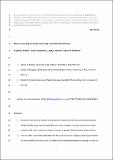Files in this item
Why is eusociality an almost exclusively terrestrial phenomenon?
Item metadata
| dc.contributor.author | Ruxton, G.D. | |
| dc.contributor.author | Humphries, S. | |
| dc.contributor.author | Morrell, L.J. | |
| dc.contributor.author | Wilkinson, D.M. | |
| dc.date.accessioned | 2015-11-19T10:10:02Z | |
| dc.date.available | 2015-11-19T10:10:02Z | |
| dc.date.issued | 2014-11 | |
| dc.identifier | 158743749 | |
| dc.identifier | f9b6e8f2-1478-4e4a-922a-eed5740ca6e4 | |
| dc.identifier | 84909948536 | |
| dc.identifier | 000344339500002 | |
| dc.identifier.citation | Ruxton , G D , Humphries , S , Morrell , L J & Wilkinson , D M 2014 , ' Why is eusociality an almost exclusively terrestrial phenomenon? ' , Journal of Animal Ecology , vol. 83 , no. 6 , pp. 1248-1255 . https://doi.org/10.1111/1365-2656.12251 | en |
| dc.identifier.issn | 0021-8790 | |
| dc.identifier.other | ORCID: /0000-0001-8943-6609/work/60427466 | |
| dc.identifier.uri | https://hdl.handle.net/10023/7819 | |
| dc.description.abstract | Eusociality has evolved multiple times across diverse terrestrial taxa, and eusocial species fundamentally shape many terrestrial ecosystems. However, eusocial species are far less common and have much less ecological impact, in aquatic than terrestrial environments. Here, we offer a potential explanation for these observations. It appears that a precondition for the evolution of eusociality is the defence and repeated feeding of offspring in a nest or other protected cavity, and so eusocial species must be able to exploit a predator-safe, long-lasting (multigenerational) expandable nest. We argue that a range of factors mean that opportunities for such nests are much more widespread and the advantages more compelling in terrestrial than aquatic ecosystems. | |
| dc.format.extent | 8 | |
| dc.format.extent | 220458 | |
| dc.language.iso | eng | |
| dc.relation.ispartof | Journal of Animal Ecology | en |
| dc.subject | Sociality | en |
| dc.subject | Social insects | en |
| dc.subject | Ants | en |
| dc.subject | Termites | en |
| dc.subject | Shrimp | en |
| dc.subject | QH301 Biology | en |
| dc.subject | SDG 15 - Life on Land | en |
| dc.subject.lcc | QH301 | en |
| dc.title | Why is eusociality an almost exclusively terrestrial phenomenon? | en |
| dc.type | Journal article | en |
| dc.contributor.institution | University of St Andrews. School of Biology | en |
| dc.contributor.institution | University of St Andrews. Centre for Biological Diversity | en |
| dc.identifier.doi | 10.1111/1365-2656.12251 | |
| dc.description.status | Peer reviewed | en |
This item appears in the following Collection(s)
Items in the St Andrews Research Repository are protected by copyright, with all rights reserved, unless otherwise indicated.

